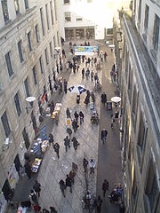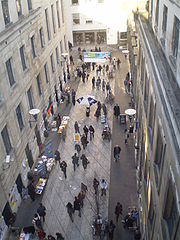
Clare Market
Encyclopedia

London
London is the capital city of :England and the :United Kingdom, the largest metropolitan area in the United Kingdom, and the largest urban zone in the European Union by most measures. Located on the River Thames, London has been a major settlement for two millennia, its history going back to its...
to the west of Lincoln's Inn Fields
Lincoln's Inn Fields
Lincoln's Inn Fields is the largest public square in London, UK. It was laid out in the 1630s under the initiative of the speculative builder and contractor William Newton, "the first in a long series of entrepreneurs who took a hand in developing London", as Sir Nikolaus Pevsner observes...
, between the Strand
Strand, London
Strand is a street in the City of Westminster, London, England. The street is just over three-quarters of a mile long. It currently starts at Trafalgar Square and runs east to join Fleet Street at Temple Bar, which marks the boundary of the City of London at this point, though its historical length...
and Drury Lane
Drury Lane
Drury Lane is a street on the eastern boundary of the Covent Garden area of London, running between Aldwych and High Holborn. The northern part is in the borough of Camden and the southern part in the City of Westminster....
, with Vere Street adjoining its western side. It was named for the food market
Market
A market is one of many varieties of systems, institutions, procedures, social relations and infrastructures whereby parties engage in exchange. While parties may exchange goods and services by barter, most markets rely on sellers offering their goods or services in exchange for money from buyers...
in established there, in Clement's Inn Fields, by John Holles, 2nd Earl of Clare
John Holles, 2nd Earl of Clare
-Family:He was born in Haughton, Nottinghamshire, the eldest son of John Holles, 1st Earl of Clare and Anne Stanhope, and the brother of Denzil Holles, 1st Baron Holles....
.
History
Clare market was originally centred on a small market building constructed by Lord Clare in c.1657, but the retail area spread through a maze of narrow interconnecting streets lined by butchers' shops and greengrocers. Butchers would slaughter sheep and cattle for sale. An area was set aside for Jews to slaughter kosher meat. The market mostly sold meatMeat
Meat is animal flesh that is used as food. Most often, this means the skeletal muscle and associated fat and other tissues, but it may also describe other edible tissues such as organs and offal...
, although fish and vegetables were also sold.
An early theatre was in Gibbon's Tennis Court
Gibbon's Tennis Court
Gibbon's Tennis Court was a building off Vere Street and Clare Market, near Lincoln's Inn Fields in London, England. Originally built as a real tennis court, it was used as a playhouse from 1660 to 1663, shortly after the English Restoration...
, in the Clare Market area. A club of artists, including William Hogarth
William Hogarth
William Hogarth was an English painter, printmaker, pictorial satirist, social critic and editorial cartoonist who has been credited with pioneering western sequential art. His work ranged from realistic portraiture to comic strip-like series of pictures called "modern moral subjects"...
, met at the Bull's Head Tavern in the market.
The area was not affected by the Great Fire of London
Great Fire of London
The Great Fire of London was a major conflagration that swept through the central parts of the English city of London, from Sunday, 2 September to Wednesday, 5 September 1666. The fire gutted the medieval City of London inside the old Roman City Wall...
, and the decrepit Elizabethan buildings survived until the area, by then a slum
Slum
A slum, as defined by United Nations agency UN-HABITAT, is a run-down area of a city characterized by substandard housing and squalor and lacking in tenure security. According to the United Nations, the percentage of urban dwellers living in slums decreased from 47 percent to 37 percent in the...
, was redeveloped by the London County Council
London County Council
London County Council was the principal local government body for the County of London, throughout its 1889–1965 existence, and the first London-wide general municipal authority to be directly elected. It covered the area today known as Inner London and was replaced by the Greater London Council...
in around 1900 to create the Aldwych
Aldwych
Aldwych is a place and road in the City of Westminster in London, England.-Description:Aldwych, the road, is a crescent, connected to the Strand at both ends. At its centre, it meets the Kingsway...
and Kingsway
Kingsway (London)
Kingsway is a major road in central London in the United Kingdom, designated as part of the A4200. It runs from High Holborn, at its north end in the London Borough of Camden, and meets Aldwych in the south in the City of Westminster at Bush House. It was built in the 1900s...
. Parts of the London School of Economics
London School of Economics
The London School of Economics and Political Science is a public research university specialised in the social sciences located in London, United Kingdom, and a constituent college of the federal University of London...
now occupy the site, and the name is commemorated in an academic journal published by the university, entitled The Clare Market Review
Clare Market Review
The Clare Market Review was established in 1905 and is the oldest student-run journal in the UK. It is based at the London School of Economics and published by the university's Students' Union.- Notable contributors :...
. Furthermore, Ralf Dahrendorf
Ralf Dahrendorf
Ralf Gustav Dahrendorf, Baron Dahrendorf, KBE, FBA was a German-British sociologist, philosopher, political scientist and liberal politician....
, the former director of the LSE, chose the title Baron Dahrendorf of Clare Market when he was made a life peer
Life peer
In the United Kingdom, life peers are appointed members of the Peerage whose titles cannot be inherited. Nowadays life peerages, always of baronial rank, are created under the Life Peerages Act 1958 and entitle the holders to seats in the House of Lords, presuming they meet qualifications such as...
in 1993. One of the main buildings at the centre of the LSE Campus is called the Clare Market Building.
External links
- Victorian London
- "The Strand (northern tributaries): Drury Lane and Clare Market", Old and New London: Volume 3 (1878), pp. 36–44

